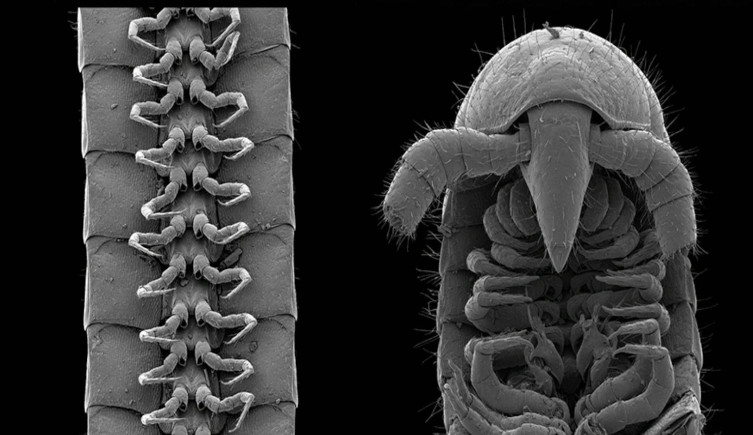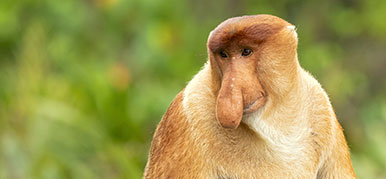A newly discovered millipede has claimed the title of the 'leggiest' animal in the world.
Eumillipes persephone was found more than 60 metres below the ground, using its 1,300 legs to push itself through the soil.

Female Eumillipes persephone have more than 1,000 legs, while males have 818. Image © Marek et al., licensed under CC BY 4.0opens in a new window via Scientific Reportsopens in a new window
A newly discovered millipede has claimed the title of the 'leggiest' animal in the world.
Eumillipes persephone was found more than 60 metres below the ground, using its 1,300 legs to push itself through the soil.
A millipede with more than 1,000 legs has been discovered, making it the first 'true' millipede.
Eumillipes persephone was discovered more than 60 metres underground in Australia, where its extreme number of legs is thought to help it move through the soil. While males have a mere 818 legs, females are more than one and a half times the size, possessing an extraordinary 1,306 legs.
Describing the new species as 'phenomenal', Dr Greg Edgecombe, who specialises in researching the evolution of arthropods and was not involved in the recent discovery, says, 'Super-elongated millipedes like Eumillipes persephone live deep in the soil.
'Many of the features of Eumillipes are traits that evolved independently in several lineages of millipedes that allow them to plough through the soil, like having long antennae to feel openings to burrow into.'
The description of the new species was published in Scientific Reports.opens in a new window

Eumillipes persephone was discovered in the Eastern Goldfields during exploration for minerals.Image © Anne-tipodees/Shutterstock
While a fly described earlier this year was said to have 'legs for days', this is nothing compared to its arthropod relatives, the millipedes.
The word millipede is derived from the Latin words for 'thousand' and 'feet', but despite this, no millipede had ever been found with the right number of legs to live up to that name.
The previous heavy hitter of the millipede world was Illacme plenipes, a millipede found in Californiaopens in a new window. Like E. persephone, it is a burrower, but only had a maximum of 750 legs, leaving it significantly short of 1,000. It also came up short in terms of depth.
'The previous record-holder for most legs was collected 11.5 metres deep in the soil,' says Greg, 'and the new finds in Western Australia were caught in traps between 15 and 60 metres underground.
'It appears that being so elongate and multisegmented allows these millipedes to have the propulsive force to thrust through crevices in the soil.'
Researchers came across E. persephone as the result of mineral exploration in the Eastern Goldfields of Western Australia. This involved digging 56 holes of varying heights into the soil to assess the precious minerals that might be found there.
In April 2020, two juveniles were revealed in the drill holes, leading researchers to set a trap 60 metres below the surface. In August, five adults were collected from the trap, while another juvenile was caught in January 2021.
At first, researchers believed that they may have been members of the same family as I. plenipes, as they looked very similar. However, it turned out that the creatures they had discovered were from a very different part of the millipede family tree.

Electron microscope images helped uncover how Eumillipes persephone was distinct from other millipede species. Image © Marek et al., licensed under CC BY 4.0opens in a new window via Scientific Reportsopens in a new window
By using an electron microscope to examine the E. persephone specimens in detail, they discovered that the surface similarities to siphonophorid millipedes was the result of convergent evolution, with similar living conditions for both species leading to adaptation along similar lines.
Genetic analysis revealed it was actually a member of the Polyzoniida, a different group of millipedes, but unlike any of its close relatives. Instead of being quite flat and wide, the specimens were very long and barely a millimetre wide.
To adapt to life underground, they also lacked eyes or colouration, along with more subtle characteristics. The many different segments allow them to squeeze through the smallest of cracks, while their structure provides force to push forward.
The sheer number of legs was also a factor, with the method of burrowing believed to be similar to the centipede with the most legs, Gonibregmatus plurimipes. However, while the largest specimen has only 382 legs, the newly discovered millipede has 1,306.
To recognise this milestone, the specimen was named Eumillipes persephone. Its genus, Eumillipes, is derived from the Latin words for 'true', 'thousand' and 'foot', recognising it as the first, and so far only, millipede to have more than 1,000 legs.
Its specific name, persephone, refers to a Greek goddess who moved to the underworld when she married its ruler, Hades.
It was given this name as the scientists believe it could have originally been a surface-dweller, but gradually adapted for life underground as the surface became drier and less inhabitable. Conditions in the soil generally maintain a similar temperature and level of groundwater, providing a stable environment to live in.
As it evolved further, E. persephone adapted for life deeper underground, with more legs providing additional burrowing power to push itself further. This may have helped it search for fungi below the surface, although the species' diet is unclear.
The millipede's discovery adds to our knowledge of the subterranean world, which, like the oceans, is severely lacking when compared to what we know about life on land or in the sky. There are likely to be many other species waiting in the darkness, undiscovered by science.
Many times, the only reason scientists come across these species is by accident when mining operations end up intruding into their habitat. While these activities help to discover species, they can also damage or destroy habitats.
As a result, there are already calls to begin conserving the newly discovered home of the leggiest of animals.

Just how weird can the natural world be?
Don't miss a thing
Receive email updates about our news, science, exhibitions, events, products, services and fundraising activities. We may occasionally include third-party content from our corporate partners and other museums. We will not share your personal details with these third parties. You must be over the age of 13. Privacy notice.
Follow us on social media